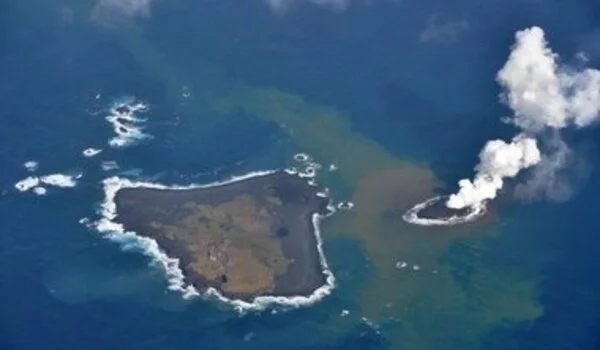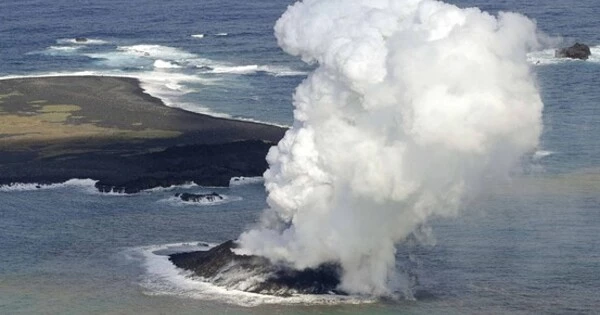Life in the smoke of underwater volcanoes is an interesting topic, as it involves a unique and extreme environment that is hostile to most life forms. Underwater volcanoes, also known as hydrothermal vents, are deep-sea fissures where hot, mineral-rich water spews out from the ocean floor. The water is heated by magma deep within the Earth’s crust and can reach temperatures of over 700 degrees Fahrenheit.
The permanently ice-covered Arctic deep sea receives minute amounts of organic matter that sustains life despite being cut off from the sun’s energy. Bacteria that can harvest energy from submarine hydrothermal sources may have an advantage. Scientists from Germany discovered bacteria that are uniquely adapted to this geo-energy floating in deep-sea waters while on research missions with the research vessel Polarstern. They describe how these bacteria contribute to biogeochemical cycling in the ocean.
Hot fluids rise from so-called hydrothermal vents deep within the ocean at tectonic plate boundaries. The fluids are oxygen-free and high in metals such as iron, manganese, and copper. Sulfides, methane, and hydrogen may also be transported by some. When hot water mixes with the cold, oxygenated seawater, so-called hydrothermal plumes form, containing smoke-like metal sulfide particles. These plumes rise hundreds of meters above the seafloor and disperse thousands of kilometers away.
We looked closely at bacteria in the genus Sulfurimonas. They were thought to have been flushed there from seafloor vent-related environments. But we wondered if the plumes might be a suitable environment for some Sulfurimonas species.
Massimiliano Molari
Hydrothermal plumes might seem like a precarious place to make yourself at home. However, that does not stop certain bacteria from flourishing just there, a study now published in Nature Microbiology finds.
More than just temporary visitors?
“We looked closely at bacteria in the genus Sulfurimonas,” says first author Massimiliano Molari of Germany’s Max Planck Institute for Marine Microbiology. So far, these bacteria have only been found to grow in low-oxygen environments, but gene sequences have been found in hydrothermal plumes on rare occasions.
They are known to use sulfide energy, as their name suggests. “They were thought to have been flushed there from seafloor vent-related environments. But we wondered if the plumes might be a suitable environment for some Sulfurimonas species.”

Tough sampling conditions
Together with colleagues from the Alfred Wegener Institute, Helmholtz Centre for Polar and Marine Research in Bremerhaven (AWI) and the MARUM Center for Marine Environmental Sciences of Bremen University, Molari thus took on a challenging sampling trip to hydrothermal plumes in the Central Arctic and South Atlantic Ocean.
“We collected plumes in previously unstudied ultraslow spreading ridges in extremely remote areas. Collecting hydrothermal plume samples is difficult because they are difficult to find. When the plume is located at depths of more than 2500 meters and below Arctic sea ice, or within stormy zones of the Southern Ocean, sampling becomes even more difficult” Antje Boetius, group leader at the Max Planck Institute for Marine Microbiology and director of the AWI, who served as the Arctic missions’ chief scientist, explains. Scientists were able to collect samples and study the composition and metabolism of bacteria onboard the research vessel Polarstern.
Well-equipped and widespread
Molari and colleagues discovered a new Sulfurimonas species, USulfurimonas pluma (the superscript “U” stands for uncultivated), which lives in cold, oxygen-rich hydrothermal plumes. Surprisingly, rather than sulfide, this microorganism used hydrogen from the plume as an energy source. The scientists also looked into the microbes’ genome, which they discovered to be severely reduced, missing genes typical of their relatives but well-equipped with others to allow them to thrive in this dynamic environment.
“We believe that the hydrothermal plume not only disperses microorganisms from hydrothermal vents, but also connects the open ocean to seafloor habitats. Our phylogenetic analysis suggests that USulfurimonas pluma descended from a hydrothermal vent-associated ancestor that adapted to higher oxygen tolerance and spread across the oceans. However, this needs to be looked into further “Molari explains.
An examination of genome data from other plumes revealed that USulfurimonas pluma is found in these environments all over the world. “Clearly, they’ve found an ecological niche in cold, oxygen-rich, hydrogen-rich hydrothermal plumes,” Molari says. “This means we need to reconsider our assumptions about Sulfurimonas’ ecological role in the deep ocean; they may be far more important than we previously thought.”
















